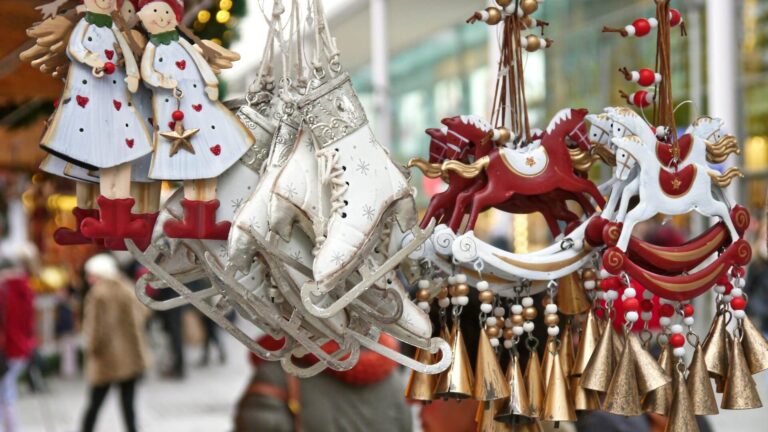
If you need a freelance travel writer or you would like to see your country, city, flight, etc., presented on the blog, drop me an email.
Find our more on Freelance Travel Writer page.
Let me tell you about visiting Arilje Serbia, because believe me, you will be surprised! The town is renowned for its raspberries and local cotton, but it’s also home to caves, waterfalls, medieval fortresses, authentic frescoes, beaches, and healing springs. Just keep reading, and you’ll see for yourself what a journey this is going to be!
FROM BELGRADE: About 190 km
FROM NIŠ: About 220 km
If you’re coming from Belgrade, the easiest way to reach Arilje Serbia is by taking a turn off the main road in Požega. From Niš, you’ll travel via Kraljevo. I drove from Ivanjica last autumn (see the post about Ivanjica Serbia)—a town that’s only 30 km away. If you have the time, you can explore both of these towns in one trip; they’re close to one another and have plenty to offer.
Arilje Serbia
Located in southwestern Serbia, Arilje sits in the basin of the mountain rivers Rzav and Moravica. The entire municipality has a population of 18,725, while the town itself is home to about 7,000 people. The town was established in 1880. Arilje is famous for its crisp, clean springs and waters, with the Rzav River being officially recognized as the cleanest in the country. Its banks are adorned with numerous beaches and fishponds today.
Nevertheless, the municipality is best known for raspberry cultivation, a tradition that began in the 1970s. Raspberries are grown across 1,200 hectares, producing an impressive 2,000 wagons of fruit annually.
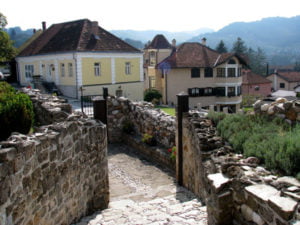
They say that ancient Romans once occupied this area, with archaeological finds in Brekovo village, where an ancient fort once stood, and remains of a Roman road that stretched from Ivanjica to Požega alongside the Moravica River. However, when you reach the center of Arilje and step onto the pedestrian St. Achillius Street, it becomes clear what the town’s main landmark is—a must-see when visiting Arilje Serbia. (The street runs from the municipality building to the church.) Step inside the church, and you’ll understand why!
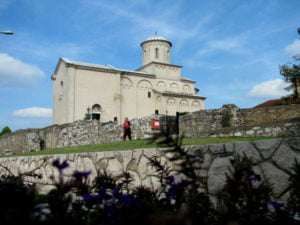
Saint Achillius Church was built in the 13th century as the endowment of Serbian King Dragutin Nemanjić. It belongs to the Raška architectural style and served as the seat of the Bishop of Moravica, one of 12 eparchies established by Archbishop Sava in 1219. After the first church was destroyed in the 13th century, King Dragutin built a new one on the same spot. His son Urošić is buried there, and the church is famous for its frescoes, which date back to the late 13th century.
According to legend, Greek migrants from Larissa arrived here in the 11th century, bringing with them the remains of St. Achillius, who is still celebrated as the town’s slava (a Serbian custom where each household celebrates a patron saint).
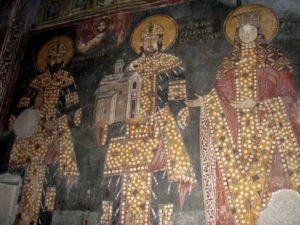
The most famous fresco is the so-called Blue Angel, which depicts St. Archangel Gabriel and is considered as artistically significant as the White Angel fresco of the Mileševa Monastery (see the post about Prijepolje Serbia). Another unique feature of the church is its display of royal dynasty members, an artistic rarity. While the names of the artists remain unknown, it’s believed they were from Thessaloniki. These frescoes mark a turning point toward a new painting style later embraced by the court of King Milutin in the 14th century.
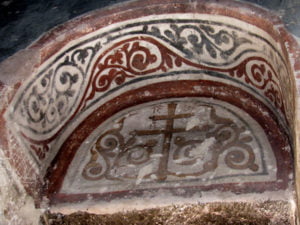
It’s assumed that Dragutin’s court was located nearby, given that his younger son was buried at the church. The area also boasts a couple of medieval fortresses from the same era: Golubinjak in Visoka village and Gradina in Trešnjevica village.
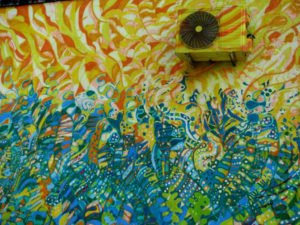
While strolling through town and taking photos of the colorful mural painted by ARLEMM Festival participants, I recalled a few interesting facts about Arilje Serbia. It’s said that, according to Serbian tradition, a kafana (a small traditional restaurant) could once be found on every corner. These were places to enjoy lunch, meet people, or seal business deals. Before World War II, there were 17 kafanas in Arilje—an impressive number for such a small town. Today, however, there doesn’t seem to be a single authentic establishment of this kind left. Still, like any other town in Serbia, Arilje is abundant in modern cafés and restaurants offering a variety of food.
I was advised not to miss the local burek with meat because, as locals say, “There’s no better way to start your day in Arilje.” If you visit during summer, make sure to try the local ice cream topped with fresh raspberry syrup. This vibrant fruit seems to follow you everywhere—you’ll even find a charming sculpture of a girl carrying a box of raspberries in the main square.
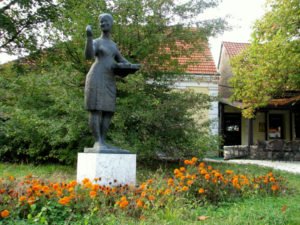
Gradina Fortress
Located in the village of Trešnjevica, this medieval fortress is still referred to as Gradina (meaning “big town” in Serbian), as there are no historical records of its original name. Its strategic significance lies in its position high atop a hill at an altitude of 1,140 meters. Recent excavations have revealed the layout of its bastions, walls, and towers. It is believed that the fortress was destroyed around the same time the famous Užice Fort was conquered by Serbian Prince Lazar in 1373. Adjacent to the fortress stands a small church, built on the same site as its predecessor, which dated back to 1811.
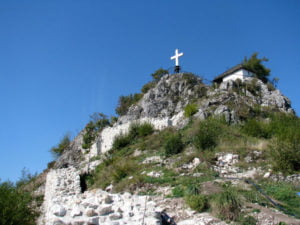
Even if you’re not a history enthusiast, Gradina deserves a spot on your “must-visit” list when exploring Arilje Serbia. The panoramic view from its walls is nothing short of breathtaking, stretching over the nearby hills and valleys. I took countless photos standing by the cross visible from the main road, while Dejan, the archaeologist, explained that some of the fortress walls date back to well before the 13th century. Imagine how magnificent this medieval stronghold must have been, with its imposing towers crowning the hilltop.
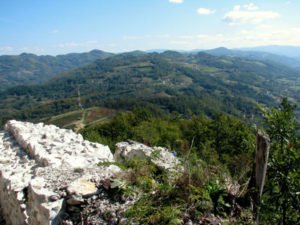
There’s also an intriguing anecdote about the small church. Locals say it just “appeared” on Gradina one morning. According to legend, the church flew itself from a nearby village during the Turkish invasion. Others believe that Serbs moved it to the hilltop overnight “with the help of God.” They even say that if you are pure and sinless, you can easily walk around the church, despite its precarious position on the very edge of the hill.
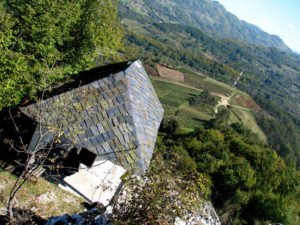
Historically, this was the site where the border between Serbia and Turkey was once established. Additionally, the famous battle of 1806 took place nearby, in the village of Trešnjevica.
While you’re in the area, be sure to visit the Klisura Monastery, located 13 kilometers from Arilje on the road to Ivanjica. Its name derives from its location in the Moravica River gorge (klisura in Serbian). Tradition holds that this monastery was an endowment of Archbishop Sava, with the church dating back to the 13th century. During my visit, the monastery complex was serene and nearly empty, save for a couple of dogs in the courtyard and the soothing sound of rushing water beneath a small bridge.
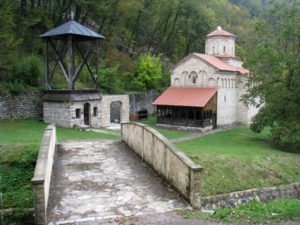
The Water Cave
The Water Cave is located in the Panjica River gorge, about 20 kilometers from Arilje, and remains largely unexplored. Research indicates that the water flowing from the cave originates from numerous springs, and speleologists believe there is a lake hidden within the cave halls. To reach the cave, you must walk about one kilometer along the Panjica River. At the cave entrance, you’ll also find an 8-meter-high waterfall.
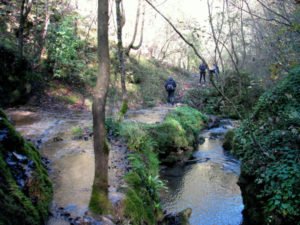
The journey to the cave is as adventurous as the destination itself. Marija from the Tourist Info Center of Arilje Serbia invited me to breakfast first (we had delicious meat-filled burek) before we set off to get some rubber boots. It was clear this wouldn’t be an ordinary visit. After a short drive, we donned the boots and began our walk. Soon, we were at the Panjica River’s edge, crossing its shallow waters several times. (I felt like a kid finally allowed to splash around!) Since then, small wooden bridges over the river were built for tourists, but then, the area retained its wild, untamed charm.
The lush greenery and the sight of the cascading waterfall are simply awe-inspiring. The river flows below while water cascades over moss-covered rocks, creating a magical scene.
But the experience doesn’t end there. A few dozen meters up the hill, you’ll encounter another shallow area, and as you step across large rocks, two massive holes appear to your right, where water bursts out with a thunderous roar!
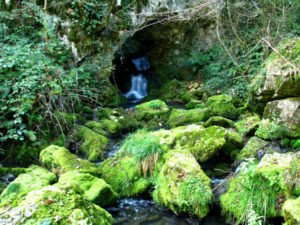
This is all easily accessible and worth the effort. Upon entering the cave, you’ll notice it’s filled with water (hence its name). The boots we wore were sufficient to explore the initial area. However, venturing deeper into the cave is not recommended, as it remains unlit and unexplored. Still, just reaching this natural vestibule is an incredible experience. The water, tumbling down into the river below, is illuminated by sunlight streaming through large openings in the rock. It’s a truly spectacular sight and an absolute must-see when visiting Arilje Serbia!
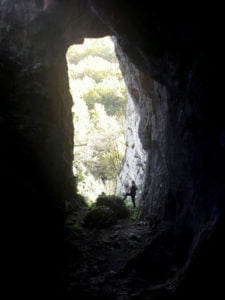
Visočka Banja
Visočka Banja is located in the Big Rzav gorge, just 30 km from Arilje Serbia, on the road towards the village of Visoka. The spa’s water originates from an underground lake, cooling down at a certain depth where minerals dissolve, before bubbling up through small rock holes. This type of gorge spring is a natural thermal rarity and the only one of its kind in Serbia and the surrounding region. The water temperature is a consistent 27 degrees Celsius, and it is believed to have healing properties for rheumatism, heart, and neurological conditions, as well as being beneficial for eye health.
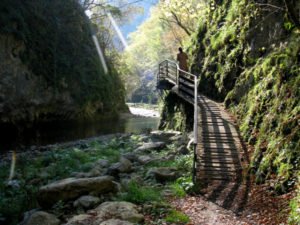
Driving to Visočka Banja is a delightful experience, especially once you leave the main road and head towards Visoka village. The narrow, winding road weaves through tall trees, offering picturesque views along the way. Near the spa’s parking area, a 400-meter trail follows the Rzav river. The crystal-clear water of the river, shifting in color from green to light blue, is truly mesmerizing. Ana from the local tourism organization, guided me through the canyon and showed me two stone pools filled with the spa’s healing waters, where you can clearly see the bubbles rising. The tranquil atmosphere, combined with the sunlight reflecting off the river’s surface, makes you feel as if the landscape itself has restorative powers.
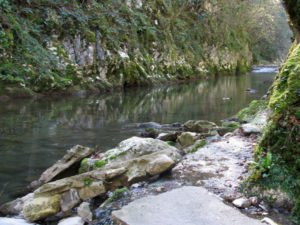
This peaceful spot was once a haven for fishermen, but it has now become a favorite destination for tourists seeking authentic natural surroundings. At the start of the trail, you’ll find a charming restaurant with a terrace overlooking the Rzav river—perfect for a relaxing lunch.

The Rzav river plays an important role in the life of Arilje Serbia. Its pristine waters support fishponds, meaning you can savor the freshest trout on your way to Visočka Banja. The river also boasts numerous beaches along its banks. The Town’s Beach is easily accessible on foot via a trail from the town center.
Slightly further, about a kilometer away, lies the Narrow Whirl—a small island that transforms each summer into the stage for the ARLEMM Festival. This popular event celebrates classical, traditional, spiritual, and jazz music, attracting numerous performers and thousands of visitors.
Beyond this, there are more beaches to discover, such as Yellow Beach and Green Beach, each offering unique experiences. During the summer months, the abundance of beaches provides something for everyone, from volleyball and football courts to evening live music shows.

The town of Arilje Serbia, is bustling with tourists in the summer, especially during the ARLEMM Festival in July. If you plan to visit, it’s wise to book your accommodation in advance. Options range from hotels to private rooms (click here). One unique choice is Villa Ravijojla, known for hosting various workshops and yoga retreats. The hostess even welcomed us in a traditional outfit, adding a touch of local charm. I personally enjoyed my stay at a little yellow hilltop house, which was just a five-minute drive from the town center.
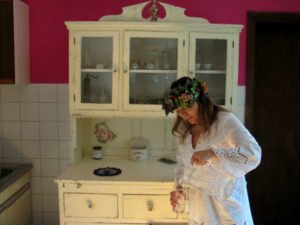
And one last tip: don’t miss the chance to stop by the Tourist Info Center in Arilje to try their specialty—raspberries dipped in chocolate, a local treat you won’t soon forget!
When I later stopped by the town (see the text Western Serbia Places to Visit), we also tried the amazing ‘Hot Raspberry.’ Take a break in the town center and treat yourself—you’ve earned a (delicious) moment of rest.
Next from Serbia: WHAT TO SEE IN LOZNICA
The full THINGS TO DO IN SERBIA section
PIN IT FOR LATER:
If you need a freelance travel writer or you would like to see your country, city, flight, etc., presented on the blog, drop me an email.
Find our more on Freelance Travel Writer page.
I am looking forward to working with you.
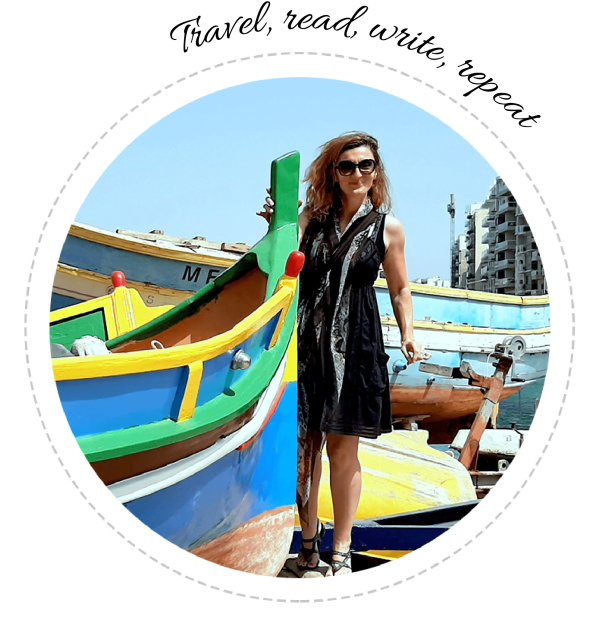



20 responses
Serbia is a spot we have never visited. But a town known for raspberries would draw me for sure. Especially if they are dipped in chocolate. I would definitely want to visit when they are in season. Fascinating to hear that there are so many Roman ruins in this hill town. I love that the Blue Angel fresco is still so vibrant and colourful. It would be good to head out of the town to see the waterfalls too. Thanks for the introduction to this town.
It’s my pleasure. So glad that the post made you curious about this part of Serbia. 🙂
Everything is pretty near to the town, so it’s possible to visit all the sites listed above in just a few days.
Thank you, Linda.
The water cave seems like a fascinating place. I often hear about orthodox churches considering cave water as particularly holy. I remember watching a show about a lost spring in Istanbul that was actually in the bottom of a fabric store. I have participated in multiple international cave expeditions so I would be surprised if the cave wasn’t fully explored and mapped but that information isn’t always readily available.
The Water Cave is still to be fully explored and mapped and thus it’s not yet safe for visitors to go deep inside its corridors. I went as far as I was supposed to, given the fact that its halls are filled with water and I couldn’t really see where I was going. But I’m looking forward to visiting it again under some better circumstances and after the speleology team finishes the job.
The surrounding landscape is also quite mesmerizing, you’d love it. 🙂
I haven’t heard of Arilje but raspberries, waterfalls, frescoes, beaches and healing springs got my attention right away! Klisura Monastery looks like the perfect spot for a picnic lunch and to sit and reflect for awhile
So true, the monastery surroundings are really peaceful.
Didn’t have the change to go in though, even though they say that it houses some pretty important medieval fresco art. Well, next time. 😉
Raspberrries were never my favorite but that me because I always had the preserved ones. I am tempted to try out fresh ones. Arilje seems like a beautiful destination for holidays.
Oh, you must visit then. If anything, just to try fresh raspberries and those with chocolate as well. 😛
Thank you, Indrani.
Wow, this looks so interesting and beautiful. After having been to Croatia last summer, I’d love to explore further countries in the Balkans; guess Serbia will be next. Thanx for sharing this informative post and including these stunning pictures.
So glad you find it interesting. Serbia is full of lavish nature and so rich in history, you’d be surprised.
Thank you for stopping by. 🙂
You had me at a town that is known for Raspberries! 🙂 Oh I would so love to go to Serbia – and you solidified it for me with the beautiful views from the fortress, the quaint Klisura Monastery and the natural beauty of the Panjica waterfall and caves. Wow Wow!
So glad you like the town and its surroundings. If you are into landscapes and nature, Serbia is the right place to be, believe me.
Thank you, Dorene! 🙂
I already love this town – just because it’s known for raspberries! So sad that the kafanas are gone now – must have been cool little places. Exploring the water cave looks like it was such a cool experience, especially seeing the Panjica waterfall ????
True, kafana is for Serbia what taverna is for Greece or typical diner restaurant for the US. There are lots of those throughout the country, but sadly so many of them are being closed just to be replaced by “modern” places. Kafana is the place where you can really get to know Serbs – who love to eat well, to have a drink or two with friends and you can easily end up being welcomed to join them at their table. 🙂
Klisura Monastery looks like the perfect place to visit. I love raspberries so that got my attention. Waterfalls look amazing there. I need to get to Serbia sooN!
If you need help, don’t hesitate to stop by again and contact me. I was fortunate enough to have been able to drive all around the country. Actually, the best way to see Serbia in my opinion is to take one slow road trip. You’ll be amazed by its nature and landscapes along the road. 🙂
Ah, raspberries dipped in chocolate! I’m already drooling. Arilje looks like my kind of town. A perfect mixture of beautiful scenery, historical sites and a varied landscape. We went on a road trip through the Balkans two years ago and wanted to get to Serbia as well, but time was very short. Now that I see how much there is to see there, I’m glad I didn’t squeeze only 2-3 days there. Serbia definitely deserves a trip of its own.
I agree, the best way to see Serbia would be to go around the country slowly. Roads are not always perfect, but there are so many things to see and do – from the bustling and modern city like Belgrade to lavish nature landscapes, torrent rivers and waterfalls, and of course – some breath taking views. 🙂 You can get the picture given that you’ve been traveling through Balkans earlier.
Thanks, Anda.
I want some ice cream with raspberry syrup! That sounds so good! But what I really love about Arilje is that it’s old, medieval even. What a cool place to explore…
Yep, lots to see. That’s what I found interesting. Of course we enjoy raspberries when we go to this area, but there’s so much more.
When ever I took a break, after visiting another beautiful sight around the area, I just stopped by for some local raspberry juice or raspberries with chocolate. What a yummy journey, right! 😀